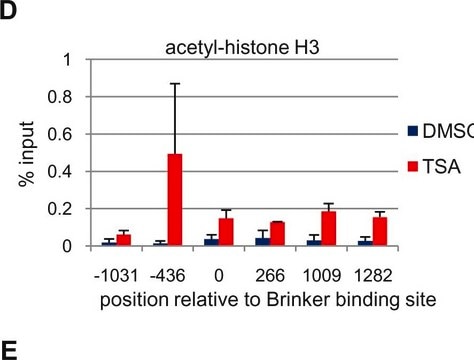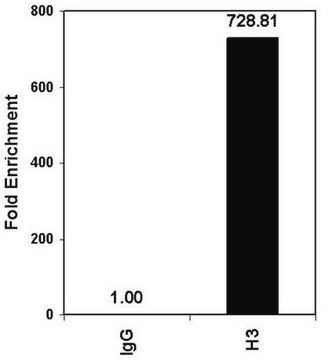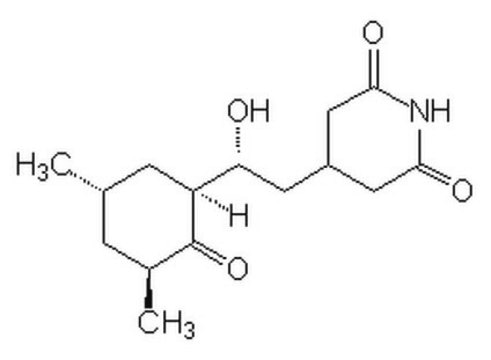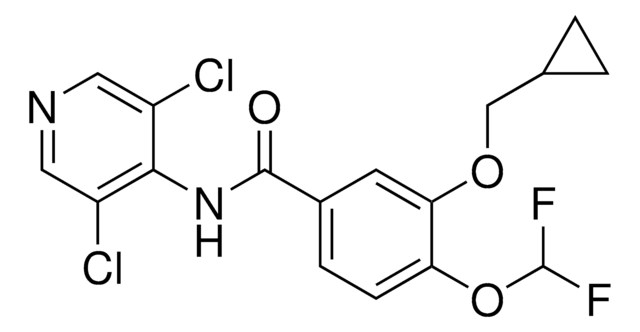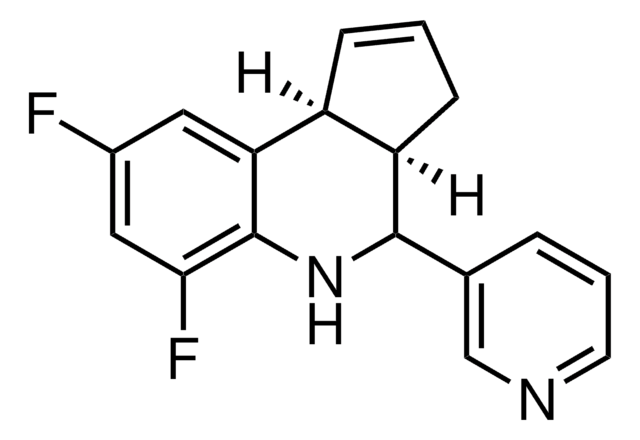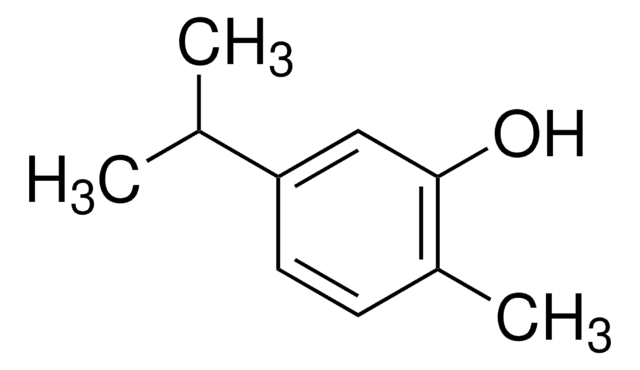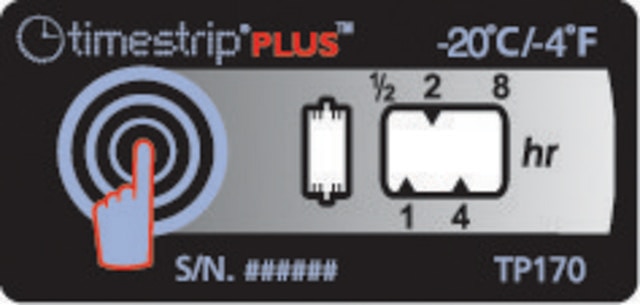17-658
ChIPAb+ Acetyl-Histone H3 (Lys9) Purified - ChIP Validated Antibody and Primer Set
from rabbit, purified by using Protein A
Synonym(s):
H3K9Ac, Histone H3 (acetyl K9)
Sign Into View Organizational & Contract Pricing
All Photos(3)
About This Item
UNSPSC Code:
12352203
eCl@ss:
32160702
NACRES:
NA.52
Recommended Products
biological source
rabbit
Quality Level
antibody form
purified immunoglobulin
clone
polyclonal
purified by
using Protein A
species reactivity
human, mouse
species reactivity (predicted by homology)
mammals
manufacturer/tradename
ChIPAb+
Upstate®
technique(s)
ChIP: suitable
immunocytochemistry: suitable
immunoprecipitation (IP): suitable
western blot: suitable
NCBI accession no.
UniProt accession no.
shipped in
dry ice
Gene Information
human ... H3F3B(3021)
Related Categories
General description
All ChIPAb+ antibodies are individually validated for chromatin precipitation, every lot, every time. Each ChIPAb+ antibody set includes control primers (tested every lot by qPCR) to biologically validate your IP results in a locus-specific context. The qPCR protocol and primer sequences are provided, allowing researchers to validate ChIP protocols when using our antibody in their chromatin context. Each set also includes a negative control antibody to ensure specificity of the ChIP reaction.
The ChIPAb+ Acetyl-Histone H3 (Lys9) set includes the anti-acetyl-histone H3 (Lys9) antibody, a negative control antibody (purified Rabbit IgG), and qPCR primers flanking an Sp1 binding site in the human p21 (WAF1/CIP1/CDKN1A) promoter, amplifying a 105 base pair PCR product. The acetyl-histone H3 (Lys9) and negative control antibodies are supplied in a scalable "per ChIP" reaction size and can be used to functionally validate the precipitation of acetyl-histone H3 (Lys9) associated chromatin.
The ChIPAb+ Acetyl-Histone H3 (Lys9) set includes the anti-acetyl-histone H3 (Lys9) antibody, a negative control antibody (purified Rabbit IgG), and qPCR primers flanking an Sp1 binding site in the human p21 (WAF1/CIP1/CDKN1A) promoter, amplifying a 105 base pair PCR product. The acetyl-histone H3 (Lys9) and negative control antibodies are supplied in a scalable "per ChIP" reaction size and can be used to functionally validate the precipitation of acetyl-histone H3 (Lys9) associated chromatin.
Specificity
Acetyl-Histone H3 (Lys9)
Immunogen
The acetyl-histone H3 (Lys9) purified antibody is made against a peptide (acetylated at Lys9) corresponding to amino acids 1-12 of histone H3.
Application
Chromatin Immunoprecipitation:
Sonicated chromatin prepared from untreated or UV treated (50 J/m2, 6 hrs.) U2OS cells (3 X 106 cell equivalents per IP) was subjected to chromatin immunoprecipitation using 5 μg of either a normal rabbit IgG or Anti-Acetyl-Histone H3 (Lys9) antibody and the Magna ChIP A (Cat. #17-610) Kit. Successful immunoprecipitation of acetyl-histone H3 (Lys9) associated DNA fragments was verified by qPCR using control ChIP Primers p21 flanking the human p21(WAF1/CIP1/CDKN1A) promoter (Please see figures). Data is presented as fold enrichment of normalized percent input of each IP sample relative to input treated or untreated chromatin.
Please refer to the EZ-Magna A ChIP (Cat. #17-408) or EZ-ChIP (Cat. #17-371) protocol for experimental details.
Western Blot Analysis:
Acid-extracted proteins from normal HeLa cells (Lane 1) and HeLa cells treated with 5 mM sodium butyrate for 24 hours (Lane 2) were resolved by electrophoresis, transferred to PVDF membrane and probed with Anti-Acetyl Histone H3 (Lys9) (1 μg/mL). Proteins were visualized using a goat-anti rabbit secondary antibody conjugated to HRP and a chemiluminescence detection system (Please see figures).
Sonicated chromatin prepared from untreated or UV treated (50 J/m2, 6 hrs.) U2OS cells (3 X 106 cell equivalents per IP) was subjected to chromatin immunoprecipitation using 5 μg of either a normal rabbit IgG or Anti-Acetyl-Histone H3 (Lys9) antibody and the Magna ChIP A (Cat. #17-610) Kit. Successful immunoprecipitation of acetyl-histone H3 (Lys9) associated DNA fragments was verified by qPCR using control ChIP Primers p21 flanking the human p21(WAF1/CIP1/CDKN1A) promoter (Please see figures). Data is presented as fold enrichment of normalized percent input of each IP sample relative to input treated or untreated chromatin.
Please refer to the EZ-Magna A ChIP (Cat. #17-408) or EZ-ChIP (Cat. #17-371) protocol for experimental details.
Western Blot Analysis:
Acid-extracted proteins from normal HeLa cells (Lane 1) and HeLa cells treated with 5 mM sodium butyrate for 24 hours (Lane 2) were resolved by electrophoresis, transferred to PVDF membrane and probed with Anti-Acetyl Histone H3 (Lys9) (1 μg/mL). Proteins were visualized using a goat-anti rabbit secondary antibody conjugated to HRP and a chemiluminescence detection system (Please see figures).
Research Category
Epigenetics & Nuclear Function
Epigenetics & Nuclear Function
Research Sub Category
Chromatin Biology
Chromatin Biology
This ChIPAb+ Acetyl-Histone H3 (Lys9) Purified -ChIP Validated Antibody & Primer Set conveniently includes the antibody & the specific control PCR primers.
Packaging
25 assays per kit, ~5μg per chromatin immunoprecipitation
Quality
Chromatin Immunoprecipitation:
Sonicated chromatin prepared from UV treated (50 J/m2, 6 hrs.) U2OS cells (3 X 106 cell equivalents per IP) were subjected to chromatin immunoprecipitation using 5 μg of either a normal rabbit IgG or Anti-Acetyl-Histone H3 (Lys9) antibody and the Magna ChIP A (Cat. #17- 610) Kit. Successful immunoprecipitation of acetyl-histone H3 (Lys9) associated DNA fragments was verified by qPCR using control ChIP Primers p21 flanking the human p21(WAF1/CIP1/CDKN1A) promoter (Please see figures).
Please refer to the EZ-Magna A ChIP (Cat. #17-408) or EZ-ChIP (Cat. #17- 371) protocol for experimental details.
Sonicated chromatin prepared from UV treated (50 J/m2, 6 hrs.) U2OS cells (3 X 106 cell equivalents per IP) were subjected to chromatin immunoprecipitation using 5 μg of either a normal rabbit IgG or Anti-Acetyl-Histone H3 (Lys9) antibody and the Magna ChIP A (Cat. #17- 610) Kit. Successful immunoprecipitation of acetyl-histone H3 (Lys9) associated DNA fragments was verified by qPCR using control ChIP Primers p21 flanking the human p21(WAF1/CIP1/CDKN1A) promoter (Please see figures).
Please refer to the EZ-Magna A ChIP (Cat. #17-408) or EZ-ChIP (Cat. #17- 371) protocol for experimental details.
Target description
17 kDa
Physical form
Anti-Acetyl-Histone H3 (Lys9) (rabbit polyclonal IgG). One vial containing 125 μg of protein A purified antibody in 125 μL storage buffer containing 0.05% sodium azide and 30% glycerol.
Normal Rabbit IgG. One vial containing 125 ug purified Rabbit IgG in 125 uL storage buffer containing 0.05% sodium azide.
ChIP Primers p21. One vial containing 75 μL of 5 μM of each primer specific for a region of the human p21 (WAF1/CIP1/CDKN1A) promoter.
FOR: GTG GCT CTG ATT GGC TTT CTG
REV: CTG AAA ACA GGC AGC CCA AG
Normal Rabbit IgG. One vial containing 125 ug purified Rabbit IgG in 125 uL storage buffer containing 0.05% sodium azide.
ChIP Primers p21. One vial containing 75 μL of 5 μM of each primer specific for a region of the human p21 (WAF1/CIP1/CDKN1A) promoter.
FOR: GTG GCT CTG ATT GGC TTT CTG
REV: CTG AAA ACA GGC AGC CCA AG
Storage and Stability
Stable for 1 year at -20°C from date of receipt
Analysis Note
Control
Included negative control antibody purified rabbit IgG and control primers specific for human p21 (WAF1/CIP1/CDKN1A) promoter.
Included negative control antibody purified rabbit IgG and control primers specific for human p21 (WAF1/CIP1/CDKN1A) promoter.
Legal Information
UPSTATE is a registered trademark of Merck KGaA, Darmstadt, Germany
Disclaimer
Unless otherwise stated in our catalog or other company documentation accompanying the product(s), our products are intended for research use only and are not to be used for any other purpose, which includes but is not limited to, unauthorized commercial uses, in vitro diagnostic uses, ex vivo or in vivo therapeutic uses or any type of consumption or application to humans or animals.
wgk_germany
WGK 2
flash_point_f
Not applicable
flash_point_c
Not applicable
Certificates of Analysis (COA)
Search for Certificates of Analysis (COA) by entering the products Lot/Batch Number. Lot and Batch Numbers can be found on a product’s label following the words ‘Lot’ or ‘Batch’.
Already Own This Product?
Find documentation for the products that you have recently purchased in the Document Library.
Daria Witt et al.
Carcinogenesis, 34(5), 1115-1124 (2013-01-26)
In this study, primary murine prostate cancer (PCa) cells were derived using the well-established TRAMP model. These PCa cells were treated with the histone deacetylase inhibitor, valproic acid (VPA), and we demonstrated that VPA treatment has an antimigrative, antiinvasive and
Jeff Ishibashi et al.
Molecular and cellular biology, 32(12), 2289-2299 (2012-04-05)
Fibroblastic preadipocyte cells are recruited to differentiate into new adipocytes during the formation and hyperplastic growth of white adipose tissue. Peroxisome proliferator-activated receptor γ (PPARγ), the master regulator of adipogenesis, is expressed at low levels in preadipocytes, and its levels
Andriy Bilichak et al.
PloS one, 7(1), e30515-e30515 (2012-02-01)
Plants are able to acclimate to new growth conditions on a relatively short time-scale. Recently, we showed that the progeny of plants exposed to various abiotic stresses exhibited changes in genome stability, methylation patterns and stress tolerance. Here, we performed
Claudio D'Addario et al.
FASEB journal : official publication of the Federation of American Societies for Experimental Biology, 25(3), 1069-1075 (2010-11-26)
Ethanol alters neural activity through interaction with multiple neurotransmitters and neuromodulators. The endogenous opioid system seems to play a key role, since the opioid receptor antagonist naltrexone (ReVia®) attenuates craving for alcohol. We recently reported that ethanol and acetaldehyde, the
Olivier Briand et al.
Molecular endocrinology (Baltimore, Md.), 26(3), 399-413 (2012-02-04)
The NR4A orphan nuclear receptors Nur77, Nurr1, and Nor1 exert multiple cellular and metabolic functions. These transcriptional regulators are activated in response to extracellular stresses, including lipotoxic fatty acids (FA) and proinflammatory cytokines. The contribution of NR4As to β-cell pathophysiology
Our team of scientists has experience in all areas of research including Life Science, Material Science, Chemical Synthesis, Chromatography, Analytical and many others.
Contact Technical Service